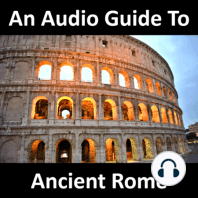19 min listen
29: Largo Argentina
ratings:
Length:
11 minutes
Released:
Sep 20, 2020
Format:
Podcast episode
Description
Largo Argentina is an exposed cluster of four temples to the south of the Pantheon and east of the Campo De’ Fiori. Today these sit in the middle of a large square and next to a bustling set of road intersections but they were originally part of a much larger temple complex in the field of Mars. Hundreds of years after the first of the four was constructed they were joined on their west by Pompey’s grand Theater.
It is not known for certain which gods should be associated with each temple so traditionally they are referred to simply by the letters A to D. They run alphabetically with rectangular Temple A on the north side closest to the wide road intersection, circular Temple B is next, continuing along we have the two other rectangular temples C and then D.
Excavations and soundings indicated that versions of the 3 rectangular Temples were in place as far back as 150 BCE. Each of these was oriented east-west with the entrance steps facing East. Before Temple B was built it appears that there was an earlier and simpler open-roofed religious space likely with a modest altar in the middle – this was thought to be associated with the ancient cult of Juno Caprotina.
In the first century BCE all four temples were in position together with a set of sacrificial altars immediately in front of their entrance steps.
Although there is not 100% certainty, the following gods have been linked to each Temple.
Temple A has been associated with Juturna the goddess of fountains, wells and springs.
Scholars have more confidence in the association of Temple B with the Roman goddess Fortuna given that parts of a colossal statue were found close by.
Temple C is the most ancient of this set of four, dating back to the 4th or 3rd century BCE. It is generally understood to be dedicated to Feronia, an ancient goddess representing wildlife, fertility, health, and abundance.
There are various competing theories for the designation of Temple D’s god however it has been well argued that it should be associated with Lares Permarini, the ancient protectors of navigation.
It is not known for certain which gods should be associated with each temple so traditionally they are referred to simply by the letters A to D. They run alphabetically with rectangular Temple A on the north side closest to the wide road intersection, circular Temple B is next, continuing along we have the two other rectangular temples C and then D.
Excavations and soundings indicated that versions of the 3 rectangular Temples were in place as far back as 150 BCE. Each of these was oriented east-west with the entrance steps facing East. Before Temple B was built it appears that there was an earlier and simpler open-roofed religious space likely with a modest altar in the middle – this was thought to be associated with the ancient cult of Juno Caprotina.
In the first century BCE all four temples were in position together with a set of sacrificial altars immediately in front of their entrance steps.
Although there is not 100% certainty, the following gods have been linked to each Temple.
Temple A has been associated with Juturna the goddess of fountains, wells and springs.
Scholars have more confidence in the association of Temple B with the Roman goddess Fortuna given that parts of a colossal statue were found close by.
Temple C is the most ancient of this set of four, dating back to the 4th or 3rd century BCE. It is generally understood to be dedicated to Feronia, an ancient goddess representing wildlife, fertility, health, and abundance.
There are various competing theories for the designation of Temple D’s god however it has been well argued that it should be associated with Lares Permarini, the ancient protectors of navigation.
Released:
Sep 20, 2020
Format:
Podcast episode
Titles in the series (36)
6: The Arch of Constantine by An Audio Guide to Ancient Rome
